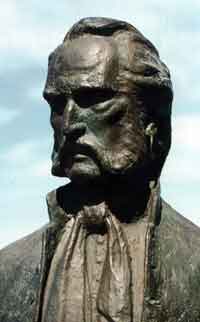|

Peter Campbell
(1780-c1832)
(Centro de Estudios Históricos, Navales y Marítimos del
Uruguay)
|
Campbell,
Peter (1780-c1832),
naval
officer and founder of the Uruguayan navy, was born in Ireland
in 1780. Little is known about Campbell's early years in
Ireland, except that he was probably apprenticed as a tanner. He
enlisted in the 71st Highland Regiment, one of the divisions
that in July 1805 sailed for the Cape of Good Hope. In 1806
these troops invaded Buenos Aires under William Carr Beresford.
After the British campaigns failed in their attempt and the
regiment withdrew, Campbell was one of the soldiers who managed
to remain in the River Plate. He joined the patriot ranks as a
guerrilla leader, harassing Spanish forces both on land and on
the Paraná river. He was notorious for his dexterity in
gaucho-style duel, wielding a long knife in one hand and
using a poncho wrapped around the other arm as a protective
measure. He carried two riding pistols, a sabre, and a large
knife in a leather sheath for his personal protection, and was
assisted by a Tipperary-born gaucho known as 'Don
Eduardo'.
Campbell
rose to prominence as a superb guerrilla fighter, serving under
José Artigas, the caudillo of a region which encompassed
the present-day Argentine provinces of Entre Ríos and Corrientes,
and much of Uruguay, a man regarded as one of Uruguay's founding
fathers. Peter Campbell played a prominent role in the affairs
of Corrientes province, and for a period after 1819 acted as its
deputy governor. He had a notable influence on the tactics
employed by the local military forces, first against the
Spaniards during the War of Independence, and later against
Buenos Aires in the civil wars that followed Argentine
sovereignty.
Peter
Campbell was responsible for establishing a regiment of mounted
Tapé indigenous people, who were feared both as a cavalry and
infantry force because their tactics were so difficult to
counteract. Armed with rifles with long bayonets attached to
them, his indigenous force was trained to charge the enemy on
horseback at great speed before dismounting and opening fire
with their rifles. Campbell's military prowess and
organisational ability were not confined to terra firma. In 1814
he began putting together a squadron of river vessels to support
Artigas on the Paraná. In 1818 Peter Campbell took charge of the
second squadron of the Uruguayan naval forces, based in Goya and
Esquina. He became naval commander-in-chief of the region and
the scourge of the Paraguayan dictator Francia's river fleet. On
21 August 1818 Artigas appointed Campbell as the first naval
commander of the patriot fleet. It is on the basis of this
appointment that the Irishman is acknowledged as the founder of
the Uruguayan navy. In September 1818 Peter Campbell managed to
seize two vessels carrying arms for the Paraguayan army. Between
January and March 1819, together with the land forces of
governor López, Campbell besieged the town of Capilla del
Rosario. On 10 March 1919 the Uruguayan army won the Battle of
Barrancas against the army of Buenos Aires. Advancing on the
Argentine city, the combined federalist forces defeated the
porteños at Cepeda (1 February 1820) and San Nicolás (13
February 1820).
However, in
the final naval battle against Monteverde on 30 July 1820,
Artigas was defeated by Ramírez, a rival warlord from Entre Ríos
province. Campbell, who initially succeeded in escaping, was
captured and banished in shackles to Paraguay. The dictator
Francia, instead of putting his former foe to death, spared
Campbell's life, possibly out of respect for his adversary's
courage and military prowess. Peter Campbell was allowed to
settle in the Paraguayan town of Neembucú, where he returned to
his former trade of tanner. There is disagreement over the
location and date of his death, which occurred around 1832.
After his burial place in Villa del Pilar was discovered in
1961, his remains were handed over to Uruguay for reinterment in
Montevideo on 18 May 1961, as befitted the founder of that
country's navy.
Edmundo
Murray
Adapted from: Jim Byrne, Philip Coleman and
Jason King (eds.), Ireland and the Americas: Culture,
Politics and History
(Santa Barbara, CA: ABC-CLIO, forthcoming 2006).
References
-
Pyne, Peter,
The Invasions of Buenos Aires, 1806-1807: the Irish Dimension
(Liverpool: University of Liverpool, Institute of Latin American
Studies, 1996). Research Paper 20.
- The
Southern Cross. Número del Centenario (Buenos Aires,
1975).
|


